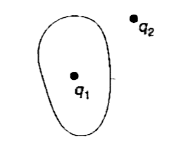The electlric flux through a certain closed surface is zero i.e. ∮S→E.−→dS=0. Does it necessarily imply that →E=0?Solution in Punjabi
Step by step video & image solution for The electlric flux through a certain closed surface is zero i.e. underset S oint vecE.vec(dS) = 0. Does it necessarily imply that vecE = 0? by Physics experts to help you in doubts & scoring excellent marks in Class 12 exams.
Updated on:21/07/2023Similar Questions
→a=|→a|→eஎனில் →e.→e என்பது
View SolutionIf the flux of the electric field through a closed surface is zero,
View SolutionThe electric flux through a closed surface is zero . What do you mean by it ?
View Solutionकिसी दी गई सतह के लिए ∮E⋅dS=0 है। इससे हम निष्कर्ष निकाल सकते है कि
View Solutionगॉस के नियम पर विचार कीजिए।
∮E⋅dS=qε0

तब, ऊपर दिखाई गई स्थिति के लिए, गॉसियन सतह पर
View Solutionयदि किसी सतह से ∫SE⋅dS=0, तब
View SolutionElectric field is the electrostatic force per unit charge acting on a vanishingly small test charge placed at that point. It is a vector quantity and the electric field inside a charged conductor is zero. Electric flux ϕ is the total number of electric lines of force passing through a surface in a direction normal to the surface when the surface is placed inside the electric field.
ϕ=∮→E.→ds=qε0
If ∮→E.→ds=0 over a surface, then
View Solution
